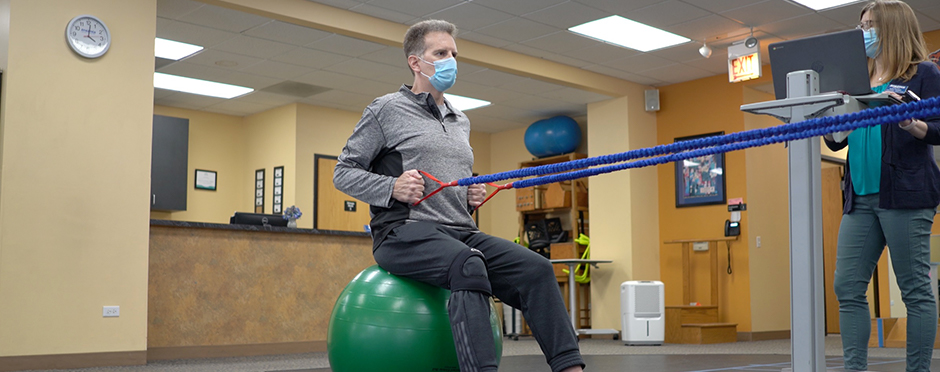
Helping COVID-19 Patients Recover
1 CommentThe COVID-19 pandemic has affected most of us in some way. For those diagnosed with COVID-19, symptom presentation is variable. The range of potential symptoms continues to be updated by the Center for Disease Control (CDC) and can impact people differently, resulting in different outcomes. The aftermath of COVID-19 can lead to physical and mental impairments as well as fear and uncertainty about long-term recovery. For many, once they have recovered from the acute stage of the virus, symptoms may remain, including weakness, fatigue and mental fog.
It’s important to know that there are resources available to help you navigate through lingering symptoms once the acute symptoms have resolved. I’d like to share my experience of providing physical therapy for a patient, Tony. Let’s review Tony’s story and his road to recovery through our COVID-19 Recovery and Rehabilitation program.
Tony had the onset of symptoms in March, which led to hospitalization. He had respiratory symptoms that required him to be on a ventilator for a few weeks. Upon discharge from the hospital, Tony initially needed to use a walker to get around at home. He was left with a myriad of symptoms including right leg pain, right arm and leg weakness, hand tremors, difficulty sitting upright and physical and mental fatigue.
Tony sought out physical therapy to assist with his recovery after discussing his symptoms with his doctor. At his initial visit, we assessed his cardiovascular, respiratory and musculoskeletal fitness. Heart rate, oxygen saturation and exertion levels were measured to establish his baselines. We discussed Tony’s deficits as they related to his daily activities, which included the following: Difficulty sitting upright through a meal, right hand tremors affecting holding a cup, pain and difficulty with walking and overall fatigue. It was also decided that a course of occupational therapy would be beneficial to help Tony regain full function of his dominant right hand.
A structured physical therapy program was created to address Tony’s deficits. Over the course of several weeks, Tony was guided through exercises to address the weakness and pain in his right leg. Balance exercises were incorporated to assist with safety during daily tasks and walking. Heart rate and oxygen saturation were monitored during his use of a stationary bike or elliptical to assess safety and progress. Exercises for posture and breathing were used to help him sustain upright sitting posture and to minimize fatigue during daily tasks.
Tony is now on the road to recovery after completing a course of physical therapy and occupational therapy. He is back at work and is walking two miles per day outdoors.
Whether hospitalized or not, a course of physical or occupational therapy after COVID-19 can assist with any lingering issues. Addressing deficits in strength, mobility, and balance; education and monitoring of vitals; building endurance; and understanding how to safely progress activity levels, will assist in your recovery and return to previous function.
If you are finding that you or a loved one, a neighbor or a friend, is struggling with their recovery after COVID-19, reach out to one of our many Athletico locations. Our COVID-19 Recovery and Rehabilitation program will help patients recovering from COVID-19 return to their previous level of function after overcoming the physical and emotional challenges that can occur from having the virus.
Visit our website to learn more about our program, how to get started, and details about waived copayments and coinsurance for first responders and licensed healthcare professionals.
The Athletico blog is an educational resource written by Athletico employees. Athletico bloggers are licensed professionals who abide by the code of ethics outlined by their respective professional associations. The content published in blog posts represents the opinion of the individual author based on their expertise and experience. The content provided in this blog is for informational purposes only, does not constitute medical advice and should not be relied on for making personal health decisions.
References:
1. “Coronavirus Disease 2019 (COVID-19).” Centers for Disease Control and Prevention, Centers for Disease Control and Prevention, www.cdc.gov/coronavirus/2019-ncov/index.html.
2. Pathak, Neha. “Life After COVID-19: The Road To Recovery.” WebMD, WebMD, 13 May 2020, www.webmd.com/lung/news/20200513/complications-on-the-road-to-recovery-after-covid.

1 Comment
Colin Crawford
Nice blog Kathy! Thanks for sharing Tony’s story.